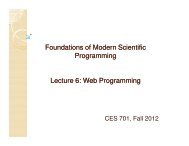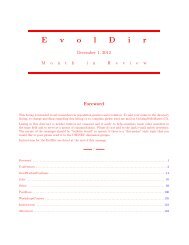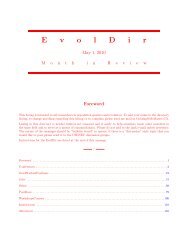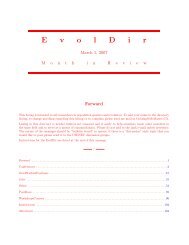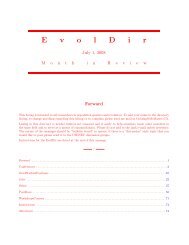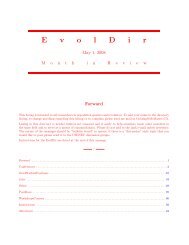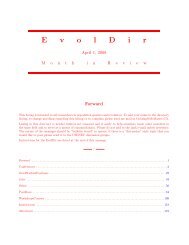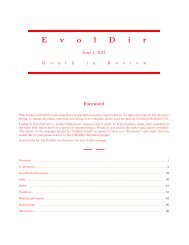E v o l D i r
E v o l D i r
E v o l D i r
Create successful ePaper yourself
Turn your PDF publications into a flip-book with our unique Google optimized e-Paper software.
December 1, 2012 EvolDir 101<br />
Dean<br />
Dr. Dean C. Adams Professor Department of Ecology,<br />
Evolution, and Organismal Biology Department<br />
of Statistics Iowa State University Ames, Iowa 50011<br />
www.public.iastate.edu/ ˜ dcadams/ phone: 515-294-<br />
3834<br />
dcadams@iastate.edu<br />
Software Transformer-4<br />
Dear EvolDir members:<br />
We are pleased to announce the release of the software<br />
T4-2.0.0, which greatly enhances the capabilities of its<br />
precedessor T4-1.3. T4-2.0.0 boosts the analysis of any<br />
genotype matrix in PC, Mac or Linux, and it admits<br />
data coding formats compatible with all the molecular<br />
techniques used in the investigation of biodiversity,<br />
either codominant (allozymes, nuclear microsatellites,<br />
SNP coded with two letters per genotype), or dominant<br />
(chloroplast microsatellites coded with three digits per<br />
haplotype, AFLPs, RFLPs, ISSR or any other molecular<br />
technique that can be binary-coded, or DNA sequence<br />
matrices). DNA sequence, SNP coded with one<br />
letter per genotype, and RAD matrices are considered<br />
dominant by T4 2.0.0, and they can only be imported<br />
to this version of T4 from fasta, mega, nexus, or phylip<br />
files.<br />
T4-2.0.0 is suitable for matrices containing an unlimited<br />
number of alleles per locus, loci, individuals, populations,<br />
or taxa (diploid individuals, in the case of codominant<br />
data). The only limit is the space available in the<br />
hard disk of the user’s computer. Most matrices resident<br />
in T4’s matrix explorer can be transformed easily,<br />
swiftly and simultaneously into the input formats of one<br />
or several of the 38 most commonly used population genetic<br />
software (and for any possible combination of the<br />
populations that each matrix contains).<br />
T4-2.0.0 also allows the users to quickly publish “genetic<br />
diversity digests” in the Demiurge information<br />
system. Such “digests” are peer-reviewed and made up<br />
by a geo-referenced T4 genotype matrix plus any ancillary<br />
information relevant to its interpretation that<br />
the authors see fit to include (see an example of a<br />
published digest in http://www.demiurge-project.org/matrix<br />
digests/14).<br />
To use T4-2.0.0, just register in the Demiurge information<br />
system by clicking on<br />
http://demiurge-project.org/register Examples of all<br />
types of matrices suitable to be imported to T4 are<br />
available in the T4 download page (http://demiurgeproject.org/download<br />
t4). An exhaustive user’s manual<br />
is available upon opening the software (clicking on<br />
“Help/Help contents”)<br />
A note about the T4 v 2.0.0 software and the Demiurge<br />
information system has been submitted to Mol.<br />
Ecol. Res. A short video summarizing the utilities of<br />
this software and the Demiurge system can be seen cliking<br />
on http://vimeo.com/29828406 . Previous versions<br />
of T4 have been downloaded and used by researchers<br />
from 26 countries, and some of the digests published in<br />
Demiurge are already associated with papers in several<br />
impact journals.<br />
T4-2.0.0 and the Demiurge system are deliverables resulting<br />
from several work packages in the project Demiurgo<br />
(MAC/1/C20). These work packages were cofunded<br />
by the Programa de Cooperación Transnacional<br />
Madeira-Açores-Canarias 2007-2013, the Instituto Tecnológico<br />
de Canarias (Gobierno de Canarias), and the<br />
Jardín Botánico Canario ≪Viera y Clavijo≫ -Unidad<br />
Asociada CSIC (Cabildo de Gran Canaria).<br />
On behalf of all the Demiurge team,<br />
Juli<br />
–<br />
Dr. Juli Caujapé Castells<br />
Head Dept. of Molecular Biodiversity & DNA bank<br />
Jardin Botanico Canario “Viera y Clavijo”-Unidad<br />
Asociada CSIC Cabildo de Gran Canaria,<br />
Associate Director of Research UNESCO chair for the<br />
conservation of Plant diversity in Macaronesia and the<br />
West of Africa Cabildo de Gran Canaria.<br />
Ap. de Correos 14 de Tafira Alta 35017 Las Palmas de<br />
Gran Canaria, Spain phone: +34 928219421 ext. 14770<br />
fax: +34 928 219581<br />
The Jardín Botánico Canario “Viera y Clavijo”-<br />
UA CSIC http://www.jardincanario.org/ The Department<br />
of Molecular Biodiversity & DNA Bank<br />
http://www.bioclimac.com/mbdna/ The Demiurge<br />
information system for biodiversity’s genetic diversity<br />
http://www.demiurge-project.org/ http://vimeo.com/29828406<br />
The Island-biodiv project http:/-<br />
/www.island-biodiv.org GreenTank, plataforma informativa<br />
sobre biodiversidad e investigación http://www.greentank.es<br />
The Island Plant Conservation Network<br />
http://www.bgci.org/ourwork/islands/ julicaujape@gmail.com



